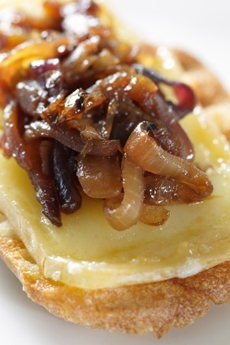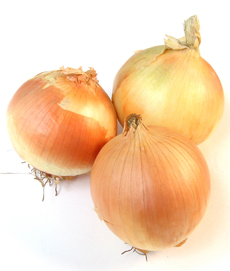
Caramelized onions on a first course or hors d’oeuvre: warm brie on a slice of French bread. Photo by Paul Binet | IST.
|
JOHNNY GNALL is a chef and food writer in San Francisco.
|
|
November 2011
|
 |
How To Caramelize Onions
Delicious, Healthy, Versatile
CAPSULE REPORT: Caramelized onions are one of life’s luscious foods. Buying a jar will cost you a small fortune, but caramelized onions are very easy to make at home. In fact, you can give them as gifts. They’ll be much more appreciated than a bottle of wine. This is Page 1 of a three-page article. Click on the black links below to visit other pages.
Introduction To Caramelization
Caramelization is a relatively simple process. For many people, however, it is one that often leads to frustration and/or burnt food.
This is because, for the average home cook, caramelization remains something of a mystery. How does one get that perfect caramel color and sweet, round flavor from a sauté pan? For most, the answer is something like, “Get your pan hot, add your vegetables, and…wait?”
While this procedure is not wrong, it is definitely vague. How hot do you want your pan? How long does the process take? How do you keep things from burning? How much oil should you use? To stir or not to stir? Suffice to say there are a number of ways things can go wrong. Armed with the right knowledge, though, you can get luscious brown color and sweet sugar flavor out of anything you put in your pan.
What Is Caramelization?
At its most basic level, caramelizing is chemistry. At 338°F, sugar begins to break down at a molecular level and form new compounds. To our eyes and understanding, this means it turns brown and becomes caramel—a broad term that extends to more than just candy and sauce.
Let’s use onions as our example. Not only do they have a very high natural sugar content—which is helpful when caramelizing—but they are also the most typical item one caramelizes.
Every time you caramelize an onion, you’re heating its molecules to 338°F, causing the water to evaporate and the sugars to change. It’s as simple as that.
The process of caramelization—the caramelization of the sugar inside the onion or other food—is a type of non-enzymatic browning, not involving amino acids, that is different from a Maillard reaction.* Instead, the sugar is oxidized.
|
|

A plain onion turns into caramelized sweetness. Photo courtesy PachD.com. |
The complications arise when variables come into play.
- Every time you caramelize something, you are dealing with a slightly different set of circumstances.
- It can be the size and thickness of the pan, the water content of the onion, even the ability to control the stove’s heat.
- Each of these conditions can affect the time and effort it takes to caramelize something.
- This is the reason so many people have trouble getting their onions just right. Either things get too hot too quickly and burn, or things take too long, which often leads to the cook giving up on achieving perfection.
*The brown caramel color in certain foods comes from a reaction between the sugar and an amino acid in food. Called the Maillard (my-YARD) reaction after the French physician and chemist Louis Camille Maillard, it’s a form of non-enzymatic browning that usually requires heat. Each type of food has a very distinctive set of flavor compounds that are formed during the Maillard reaction. The color and flavor of toasted bread and nuts; barbecued, roasted and seared meats; and roasted coffee (and many other flavors) are the result of Maillard reactions. And of course, caramel candy is the result of a Maillard reaction.
Continue To Page 2: Recipe To Caramelize Onions
Go To The Article Index Above

|



